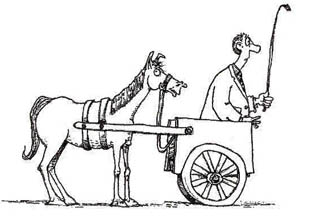
Cart before the horse for CRM?
March 12, 2015 - Comments Off on Cart before the horse for CRM?
Article First published at The Ticketing Institute
I’m constantly surprised by how many organisations, when thinking and talking about CRM (Customer Relationship Management) and their CRM Strategy focus on the IT implementation that is the customer database technology. True it’s important but if technology is applied to a faulty business strategy all that will happen is the organisation becomes more efficient at doing the wrong things! The main goal is to have a 360° view of your customer because CRM is a strategy not a process, tactic or just a marketing function.
Keep these 5 things in mind and you can’t go far wrong:
- CRM isn’t CRM unless it affects the customer’s experience
- CRM is a strategy, not a project
- CRM should improve ROI
- Technology is a means, not an end
- You want a 360 degree view of your customer
That said IT and/or software are vital to its success. CRM software collects data on consumers and their transactions. And the point of a system is to find a repository to hold your valuable data on your customers and stakeholders. Key to this is centralising your data and business operations so that it’s all in one place, making sure that it’s relevant and contacts are still ‘live’ and being talked to by you.
And here are the steps you might take in your CRM Strategy, notice that Get the Right System for your Organisation is right at the bottom of the list – that’s not about importance but the journey:
Understand your customers and customer journeys
You must have a clear vision of what good CRM looks like across the organisation, including understanding customer journeys. A customer journey is how your customer interacts with your organisation across multiple touch-points, such as purchasing a ticket, attending an event, and providing feedback. Align your internal business processes with these journeys and it will help you determine if you're easy or difficult to do business with.
Differentiate your customer segments, and understand and agree behaviours, whether you segment by high value, frequency of attendance, potential attendance, participation, etc.
Create communication and implementation plan
Create a communication plan to allow you to share actionable items within the strategy, and progress charts that show what has been implemented and where. Create an implementation plan, and include a feedback loop that allows everyone to highlight problems with implementation or execution. Ideally, with clear leadership in place most senior managers will have responsibility for managing CRM strategy at an operational level.
Be a customer focussed organisation
Your organisational culture needs to be ready to adopt a customer-centric approach. Set up a CRM team with representatives from each department or area so that colleagues' needs and concerns are addressed. Consider creating an education programme for the entire staff, including third parties who may have involvement in interactions with the organisation’s customers. Put in place clear measures that show everyone the value of adopting and applying the strategic initiatives and don't forget to celebrate excellence when it is achieved. You will know when you are at a point of excellence by setting KPIs at the outset.
Tidy up your data
Customer data is a critically important part of any CRM project, so it is important to ensure your data management is in good shape before strategy building begins in earnest.
Remember, the old adage: garbage in, garbage out. Without having data on your customers, you can’t learn what does and doesn't engage them, and what effect this engagement does or doesn’t have. So before you can do CRM, you need a decent data collection policy, and the means to analyse the data in the context of the CRM programme you envisage for them. And it should go without saying that it’s vital to make sure all data is accurate and up to date.
Get the right system for your organisation
Choosing the right system will help you achieve your business and CRM objectives, in developing all potential revenue streams and building a 360 degree view of your customer and their needs. Choosing the wrong system could spell financial and customer relationship disaster! It involves a five-step process and is something I and my colleagues at the Ticketing Institute can help you with:
- Information Gathering
- Specification
- Priced Tenders
- Evaluation, and
- Implementation
Published by: Helen Dunnett in My Blog





Comments are closed.